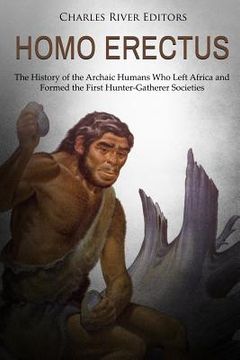Homo erectus: The History of the Archaic Humans Who Left Africa and Formed the First Hunter-Gatherer Societies (en Inglés)
Reseña del libro "Homo erectus: The History of the Archaic Humans Who Left Africa and Formed the First Hunter-Gatherer Societies (en Inglés)"
*Includes pictures *Includes online resources and a bibliography for further reading Most scientists believe the evolution of humans has a history as long as life itself. Anatomically modern humans and all other life that has existed on the planet first came about from the single-celled microorganisms that emerged approximately 4 billion years ago. Through the processes of mutation and natural selection, all forms of life developed, and this continuous lineage of life makes it difficult to say precisely when one species completely separates from another. In other words, scientists still debate when a human became a human rather than the ancestor species that came before. Around 1.8 million years ago, a third species of Homo appeared in the fossil record. H. erectus would have shared the landscape for a time with H. habilis and H. rudolfensis, but the fossils of H. erectus are not limited to eastern and southern Africa. Instead, they are found across Africa and parts of mainland and insular Asia. This is the first species of Homo to be found outside Africa (Rightmire 1993). Features of H. erectus suggest an evolution toward modern humans, and the features which separate H. erectus from the other Homo species are found in the skull. The size of the brain was approximately 900 cc, making it larger than the brain size of H. habilis. H. erectus would not have the largest brain capacity of the Homo genus during its existence, with the emergence of H. heidelbergensis approximately 800,000 years ago. The larger brain size may not matter much when the size of the brain is considered with the size of the body, which also increased. While the facial features of H. erectus would have made them noticeably different if they were alive today, their postcranial morphology may have been similar to modern humans. A key difference is the density or thickness of the bones; in H. erectus the limb bones are more robust, but otherwise they appear very similar to modern humans. The length of the hindlimbs in relation to the arms is similar to modern humans, which means that H. erectus may have been able to walk in a similar way. (Richtmire 1993: 57-84). This may or may not be linked with the widespread distribution of H. erectus. Perhaps more important for H. erectus than simply being able to walk out of Africa would have been the ability to adapt to changing climates and essentially modify the environment around them. Most notably, the major advantage that H. erectus would have had is the ability to control fire. This skill, which no other animal has mastered, helped H. erectus travel across the world, and it may date as far back as 1.7 million years ago to as recently as 200,000 years ago. Most scientists agree that H. erectus was able to control fire by at least 600,000 years ago, and anatomically modern humans were able to create and use fire 150,000 years ago. The early species of Homo would have been familiar with the effects of fire, from the devastation it could cause to jungle habitats to the rapid spreading wildfires of the savanna. These fires would have killed and burned animals that early Homo would have found while scavenging after a natural fire. Homo erectus: The History of the Archaic Humans Who Left Africa and Formed the First Hunter-Gatherer Societies examines how H. erectus evolved, and what their lives were like. Along with pictures of important people, places, and events, you will learn about H. erectus like never before.

